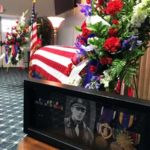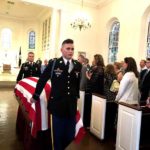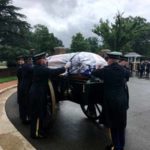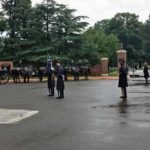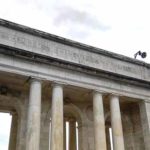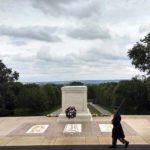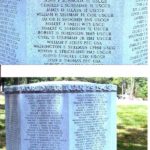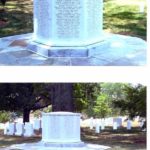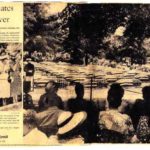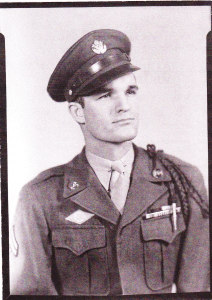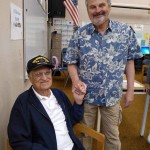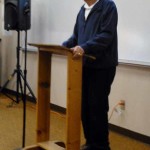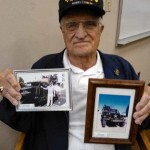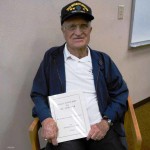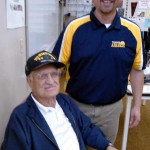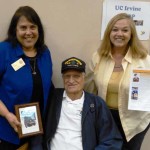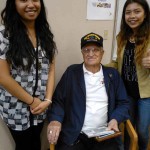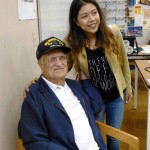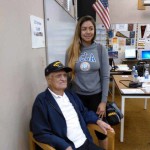AHS Remembers Classmates Lost in WWII Explosion of USS Serpens
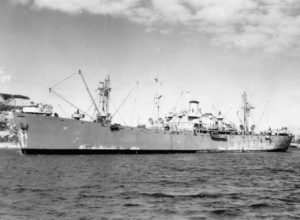 Anaheim High lost two 1940s classmates in what was the largest single disaster suffered by the United States Coast Guard in World War II, when the USS Serpens exploded in Guadalcanal on the night of Jan. 29, 1945.
Anaheim High lost two 1940s classmates in what was the largest single disaster suffered by the United States Coast Guard in World War II, when the USS Serpens exploded in Guadalcanal on the night of Jan. 29, 1945.
Charles E. Graeber from Class of ’40 and James D. Selaya from Class of ’42 were among the 250 men who died in the explosion that destroyed the 14,250-ton ammunition ship.
Both Graeber and Selaya were U.S. Coast Guard sailors and most likely good friends who grew up together in, then, small town Anaheim.
Charles, who was called by his nickname “Chuck,” was born May 7, 1922, to Ernest and Veronica Graeber. The family home was located at 408 West Oak Street. Ch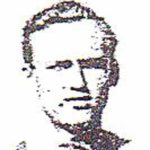 uck played football and basketball. He served as a Pharmacist’s Mate 3rd Class.
uck played football and basketball. He served as a Pharmacist’s Mate 3rd Class.
 Selaya, who was called Jim or Jimmy by his family and friends, was captain of the B Football Team, ran track for three years and was the school’s feather weight boxing champion.
Selaya, who was called Jim or Jimmy by his family and friends, was captain of the B Football Team, ran track for three years and was the school’s feather weight boxing champion.
Of the 250 men who died in the explosion, 193 were U.S. Coast Guard sailors; 56 U.S. Army soldiers; and Dr. Harry M. Levin, a U.S. Public Health Service surgeon. Of the 193 Coast Guardsmen, 17 were regular Coast Guard and 176 were reservists.
There were 10 survivors. Lieutenant Commander Perry L. Stinson, commanding officer of the USS Serpens, another officer and six crewmen were ashore on administrative business. Two crewmen who were onboard survived the explosion: SN 1st Class Kelsie K. Kemp of Barron Springs, Virginia, and SN 1st Class George S. Kennedy of San Marcos, Texas. Seaman Kemp and Seaman Kennedy were awarded the Purple Heart by Rear Admiral L.T. Chalker, the Assistant Commandant of the U.S. Coast Guard.
It took several years to confirm the cause of the explosion. In July 1947, the Coast Guard still thought an enemy attack had caused the blast. However, by June 10, 1949, it was determined as an accident that occurred when servicemen were loading depth charges. The ship, anchored off Lunga Beach in the British Solomon Islands, was preparing to deliver ammunition for the Battle of Okinawa, the last major battle of World War II, and one of the bloodiest.
The 250 remains were originally buried at the Army, Navy and Marine Cemetery in Guadalcanal with full military honors and religious services. The remains were repatriated under the program for the return of World War II dead in 1949.
 The mass recommittal of the 250 unidentified dead took place in section 34 at MacArthur Circle in Arlington National Cemetery. The remains were placed in 52 caskets and buried in 28 graves near the intersection of Jesup and Grant Drives. Two gravesites were reserved for the memorial inscribed with their names.
The mass recommittal of the 250 unidentified dead took place in section 34 at MacArthur Circle in Arlington National Cemetery. The remains were placed in 52 caskets and buried in 28 graves near the intersection of Jesup and Grant Drives. Two gravesites were reserved for the memorial inscribed with their names.
About 1,500 people attended the reinternment service on June 15, 1949. Catholic, Jewish and Protestant chaplains officiated. The U.S. Marine Corps Band played Pasternak’s arrangement of Taps. A bugler echoed Taps in the distance. The U.S. Navy also participated. To conclude the service, a Gold Star Mother, escorted by an American Legionnaire, placed a white carnation on each casket.
In a newspaper account of the service, one witness described it as “one of the most elaborate military services” accorded our fallen heroes. “Words would have been inadequate to express the deep gratitude and admiration…in the hearts of [all] who witnessed the service.”
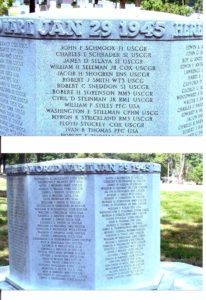 The USS Serpens Monument was dedicated on Nov. 16, 1950.The octagonal monument occupies two grave spaces in section 34. About 100 relatives and 200 others attended the dedication. Participating units included a color guard from the U.S. Coast Guard Cutter DUANE, a color guard from The Old Guard at Fort Myer, Catholic, Jewish and Protestant chaplains, and The United States Army Band (Pershing’s Own). Vice Admiral Merlin O’Neill, Commandant, U.S. Coast Guard gave a brief address that include the statement: “We cannot undo the past, but we can insure that these men shall be respected and honored forever.”
The USS Serpens Monument was dedicated on Nov. 16, 1950.The octagonal monument occupies two grave spaces in section 34. About 100 relatives and 200 others attended the dedication. Participating units included a color guard from the U.S. Coast Guard Cutter DUANE, a color guard from The Old Guard at Fort Myer, Catholic, Jewish and Protestant chaplains, and The United States Army Band (Pershing’s Own). Vice Admiral Merlin O’Neill, Commandant, U.S. Coast Guard gave a brief address that include the statement: “We cannot undo the past, but we can insure that these men shall be respected and honored forever.”
Click here to view a list of names of those who lost their lives in the USS Serpens disaster.
Remains of Colonist WWII Hero Recovered
John H. Liekhus – June 17, 1915 – Nov. 2, 1944
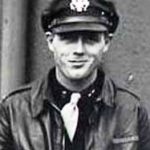 It’s taken 73 years for Anaheim’s Class of 1934 Colonist John Liekhus to return home. His remains were recently recovered from farmland in Germany where the B-17 he piloted crashed on Nov. 2, 1944, according to a press release from Defense POW/MIA Accounting Agency (DPAA).
It’s taken 73 years for Anaheim’s Class of 1934 Colonist John Liekhus to return home. His remains were recently recovered from farmland in Germany where the B-17 he piloted crashed on Nov. 2, 1944, according to a press release from Defense POW/MIA Accounting Agency (DPAA).
He and his crew members will be buried next year with full military honors at Arlington National Cemetery in Virginia.
First Lt. John Liekhus was a flyer with the 323rd Bombardment Squadron, 91st Bombardment Group, Eighth Air Force.
Liekhus and his crew were on a bombing mission to Merseburg, Germany, when their plane was hit by flak. As the B-17 fell out of formation, German fighters attacked. Witnesses reported seeing the aircraft burst into flames and descend rapidly. It crashed two kilometers (just over one mile) southwest of the town of Barby, according to the DPAA .
Facts that have emerged from the investigation include this story of the crash showing the immense courage of Liekhus and his crew:
When he realized his plane was going down, Liekhus ordered his nine-member crew to bail. Co-pilot Robert Wisor, who was captured after bailing out of the doomed plane, gave the following testimony in an Army “Casualty Questionnaire” dated Feb. 27, 1946, obtained from the Library of Congress:
“Second Lt. Robert Sambo (bombardier) bailed out of the plexiglass nose (which was shot out) before the plane went into a tail spin.” (Sambo survived the war as a POW.) “Staff Sgt. B. Lombardi (tail gunner) jumped out of the tail escape hatch at approximately the same time as the bombodier.” (Lombardi also became a POW.)
A crew member who died in the crash tried to save the flight navigator by pushing him through the nose of the stricken bomber. The navigator died before hitting the ground and his body was recovered a few months later. The five other crew members, including Liekhus, were declared missing in action.
In January 1951, the American Graves Registration Command (AGRC) concluded that the five unaccounted-for crew members perished in the crash and the location of their remains was unknown.
That conclusion changed, however, after Liekhus’ great nephew, Michael Cushing, a retired Anaheim physician, began researching the crash, contacting survivors and encouraging the US Government to re-open the investigation. With the help of the German government, the DPAA was able to recover trace remains of Liekhus and his crew members. They will be buried next year with full military honors at Arlington National Cemetery in Virginia.
First Lieutenant Liekhus was 29 years old when he was piloting the B-17G flying fortress nicknamed “Bomber Dear” on a strategic mission to bomb Merseburg oil refineries. Ultimately, the denial of refined petroleum products would be instrumental in ending Hitler’s pursuit of world domination.
A ring of 400 anti-aircraft guns, twice the number protecting Berlin, had been brought into the Merseburg refinery corridor in a desperate attempt to protect Germany’s dwindling petroleum supply. The guns took their toll in men and machines.
Anaheim High Class of 1939 Bruce Alexander met the same demise as Liekhus. A second lieutenant, Alexander was also attached to the 8th Air Force. He died a month after Liekhus on Dec. 6, 1944, after being shot down during a Merseburg raid.
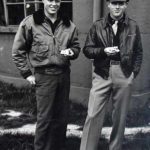 Liekhus’ brother Leonard, also a decorated WWII bomber pilot, was the last to see John alive. Another brother, Gene “Eugene,” served in WWII as well. They were the sons of Joseph B. and Gertrude E. Liekhus, who brought their family to Anaheim in the early ‘30s after losing their farm in Cedar Rapids, Neb., during the Great Depression.
Liekhus’ brother Leonard, also a decorated WWII bomber pilot, was the last to see John alive. Another brother, Gene “Eugene,” served in WWII as well. They were the sons of Joseph B. and Gertrude E. Liekhus, who brought their family to Anaheim in the early ‘30s after losing their farm in Cedar Rapids, Neb., during the Great Depression.
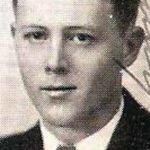 When the Liekhus family arrived in Anaheim the population was close to 10,000 and the student population at Anaheim High was approximately 900, including freshman, sophomores, juniors and seniors. By the time the war broke out in the 1940s, Anaheim’s population increased only 3 percent.
When the Liekhus family arrived in Anaheim the population was close to 10,000 and the student population at Anaheim High was approximately 900, including freshman, sophomores, juniors and seniors. By the time the war broke out in the 1940s, Anaheim’s population increased only 3 percent.
Anaheim High lost 35 known graduates in WWII. Other students were removed from the student body after their families were deported to Japanese relocation camps.
Fortunately for the Liekhus family, their other two sons both returned home, and another son survived the Korean War. Gene, who resides in Washington state, is John’s only living brother. His only living sister is Trudy “Gertrude” Reynolds, age 91, who lives in Redondo Beach. Other siblings included sisters Henrietta, Irene, Helen, and Jeanette “Jean.”
The Liekhus home at 617 S. Helena Street was not the only home with a Gold Star service flag in the front window, indicating that their son had given the ultimate sacrifice for his country.
 Families of other Anaheim boys were also were reported missing in action and their bodies never recovered. Bomber pilot Mark Anderson (Class of 1934), paratrooper Ben G. Foland (Class of 1935), infantryman Rex Middleton Woodward (Class of 1930), and infantryman Jack Skinner (Class of 1930) are other Colonists listed on the Henri-Chapelle Tablets of the Missing at the American Cemetery in Belgium. Some 73 years later, a rosette will be placed on the tablet next to Liekhus’ name to indicate his remains have been found.
Families of other Anaheim boys were also were reported missing in action and their bodies never recovered. Bomber pilot Mark Anderson (Class of 1934), paratrooper Ben G. Foland (Class of 1935), infantryman Rex Middleton Woodward (Class of 1930), and infantryman Jack Skinner (Class of 1930) are other Colonists listed on the Henri-Chapelle Tablets of the Missing at the American Cemetery in Belgium. Some 73 years later, a rosette will be placed on the tablet next to Liekhus’ name to indicate his remains have been found.
Anaheim High is making sure the service and lives of these fallen Colonists and Anaheim sons and daughters are remembered.
On Nov. 7, 2013, the Anaheim High football program honored Colonist veterans during an “Honor Game.” During the half-time tribute, families of the fallen were presented with specially designed jerseys worn by the players.
AHS varsity player Juan Bocardo wore jersey #60 imprinted with Liekhus’ name. Liekhus also played football for Anaheim High, as well as basketball and served on the Deportment Committee. After graduating from Anaheim, John went on to work for Douglas Aircraft Co. in Long Beach. When the United States entered WWII, John was considered an “essential war worker” but talked his boss in letting him enlist in the Army.
The bravery of Liekhus and his Colonist classmates will never be forgotten.
WWII Alumni “Teacher of the Day” at Anaheim High
When AHS alumni history teacher Alex Lamb from Class of 1967 learned there was an Anaheim graduate who served in WWII living just blocks from the school, he immediately contacted the AHSAA to arrange a speaking date for his students who were studying the Battle of the Bulge.
Robert Fischle from AUHS Class of 1941 accepted the invitation to share his memories of fighting in the 40-day battle in the freezing cold. Gathered before two classes of AHS history students, the 92-year-old veteran and life-long Anaheim resident told students that the best part of the war was making it home alive and the worst part was the weather, recalling the horror of driving over frozen corpses as a gunner in an Army M-15 Half-Track, a large truck-type vehicle with front wheels and rear tracks.
The Half Track was equipped with two 50-caliber machine guns firing 500 rounds per minute and a 37-milimeter canon that fired 120 rounds per minute. Fischle job was to sit in the truck’s “bucket” and operate the machine guns. In his Small Town Kid to Big Time War memoir, Fischle recounts how his elite 390th Special Battalion Unit of 675 soldiers crossed the European continent for 281 days of combat in the Third Army commanded by General George Patton.
On July 7, 1944, the 390th Battalion landed on Utah Beach with the mission to protect the Third Army’s supply dumps. As they began their advance across Europe, the main objective was to shut down enemy aircraft to prevent destruction of bridges. Keeping these structures intact was of vital importance to the success of U.S. Army operations.
“We advanced day and night, over mountains, through dense forests, across broad rivers, pressing ever onward in pursuit of victory,” Robert wrote in his memoir. His biggest worry, he told the history students, was dodging strafe coming from low-flying enemy aircraft that would appear suddenly from the clouds. Fischel recalled several near misses when the bullets whizzed around him but never made contact.
His unit’s ultimate destination was Belgium’s densely forested Ardennes region on the edge of the Western Front. As the students are learning, it was the largest and bloodiest battle Americans fought in World War II, leaving 90,000 Americans wounded and 19,000 dead. The 390th made history during the Battle of the Bulge, shooting down 13 German planes in 17 minutes. The unit received commendations from U.S. Army Generals Patton, Eisenhower, Marshall, Bradley and more.
The Class of ’41 vet also talked about his days growing up in Anaheim. With a father who owned a confectionary shop in downtown Anaheim, Fischle was literally the kid who grew up in a candy store. His family home was located at 326 S. Melrose St., a nd he attended Broadway Elementary School, Fremont Junior High, then Anaheim, entering as a freshman in 1936 just as the new school buildings opened after being reconstructed after the 1933 Long Beach earthquake. He played football, basketball and track all four years.
nd he attended Broadway Elementary School, Fremont Junior High, then Anaheim, entering as a freshman in 1936 just as the new school buildings opened after being reconstructed after the 1933 Long Beach earthquake. He played football, basketball and track all four years.
Fischle’s extracurricular activities leaned toward fast cars. In school he was called Bob or his nickname “Fish” and his best buddy was Bob Spielman. The duo rode in a Willy’s roadster any time they could scrounge up some gas money. When their tank was full of 10.9-cents- a-gallon-gas, the duo headed for Huntington Beach and other favorite spots.
He left Anaheim as a 19 boy and returned home four years older, a battle-scarred man. “It took me a while to get my feelings back,” he answered when asked how he dealt with coming home with memories of the death and destruction he witnessed during the war. “When I sit on my patio and see big white clouds, I always remember the enemy aircraft coming at us. It was kill or be killed.”
- Robert Fischle ’41 with AHS alumni history teacher Alex Lamb 67.
- Fischle told students about his WWII experience as a gunner on a half-track.
- Fischle holds photos of half-tracks, a unique Army anti-aircraft vehicle.
- An Army M-15 Half-Track
- Fischle wrote a memoir about his experience as a member of the Elite 390th Special Battalion Unit.
- Alex Lamb ’67, Robert Fischle ’41 and Mark Monning ’79.
- Fischle with AHS history teacher Mr. Zambrano.
- AHSAA Board members Debbie Vidana ’76 and Janet Brown ’77 helped bring WWII Vet Robert Fischle to the campus.
- AHS history students Ashley Mariano (l) and Genesis Jimenez asked for photos with WWII hero Robert Fischle.
AHSAA Fallen Heroes Spotlight: Manuel G. Moreno ‘51 – A Story of Courage
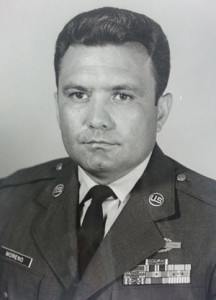 The life history of Anaheim High’s Class of 1951 alumnus Manuel “Tony” G. Moreno Jr. is, foremost, a story of courage. However, when you hear the entire saga of this brave American soldier, you’ll agree his story rings of dedication, perseverance and, ultimately, forgiveness for wounds suffered to the honor of his service.
The life history of Anaheim High’s Class of 1951 alumnus Manuel “Tony” G. Moreno Jr. is, foremost, a story of courage. However, when you hear the entire saga of this brave American soldier, you’ll agree his story rings of dedication, perseverance and, ultimately, forgiveness for wounds suffered to the honor of his service.
Even after being captured just two weeks upon entering the Korean War, then spending 27 months as a POW, Moreno dedicated his life to his country as a career military man. The experience earned him five Purple Hearts and a chest full of medals.
If surviving the torture of a prisoner of war camp wasn’t enough to prove his dedication to country, Moreno returned to service after his release; then, upon discharge, re-enlisted in the U.S. Air Force. When he retired from active duty, he worked at the Naval Base in Jacksonville, Florida, until retiring in 2004.
His story begins in Tucson, where he was born to Manuel Moreno Sr. and Betty Aguilar. He grew up in Anaheim with his mother and stepfather Raymond O. Hernandez. At age 17, Moreno joined Anaheim’s Company K National Guard Division. Soon after, he voluntarily joined the U.S. Army to fight in Korea.
News stories about Moreno say that his combat unit came under attack and he was severely wounded. He and another soldier spent five days trying to get back to their battalion but were captured.
Sometimes called the “forgotten war,” the Korean Conflict is not lost in the memories of the 7,140 soldiers who were held captive. The official death rate was roughly 40 percent and more than 2,700 POWs are known to have died in captivity. Torture and attempted brainwashing was common among POWs in North Korea. Even deadlier was neglect of their dietary and medical needs. Also, there were 8,200 soldiers left in Korea whose remains are still unknown.
His half-brother, Raymond A. Hernandez Jr. from AHS Class of 1963, was 6 years old when his brother was taken prisoner. “When he was released in 1953, I was 8 and it was a very exciting time for our family,” remembers Raymond. “There was a lot of hugging and partying with relatives coming from other states to celebrate his return to our home at 316 N. Philadelphia St.”
Moreno became the first POW from Orange County, as well as Anaheim, who was freed from the horrendous conditions and torments of a Korean POW camp. While his family rejoiced, Korean War POWs were not embraced by a grateful nation.
Moreno’s patriotism was not diminished by the experience. Not even later when his Purple Hearts and military medals were stolen from his home, an act of cowardice that his family tried to rectify by having the medals replaced. They were successful in finding duplicates, but never replaced all five of his Purple Hearts.
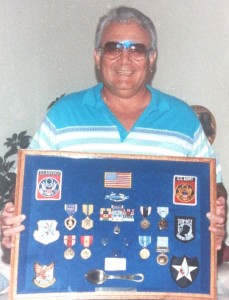
Moreno with a shadow box of duplicate medals presented to him by his family after his originals were stolen.
The originals went missing for nearly 40 years until Kathryn Kinal from Ann Arbor, Michigan, found his medals at an auction in 2012. When she saw a Purple Heart was for sale, her sole goal was reuniting it with the rightful owner. The search took years and she didn’t get a break until an article about Moreno appeared September 2013 in the Orange County Register.
Even after coming across the story, she still couldn’t find Moreno or Hernandez. Finally she contacted government offices in East Troy and, three days later, Kinal received an email from Paula Bates, Moreno’s sister-in-law, only to learn Moreno had died Feb. 1, 2014.
Hernandez summed up his brother’s story: “To me, Manuel has always been a hero in my eyes. He was that heroic soldier who endured a terrible, torturous time in Korea. He fought in several battles and suffered as a POW. But he survived because he was a fighter. I’ll always be very proud of him and keep him medals as memorial to his bravery and to that of his fellow soldiers.”Despite the disappointment, Kinal proceeded with what she set out to do, and when family members received the lost medals, their reaction was joy, disbelief and gratitude to Kinal for going above and beyond the call of duty.
Saluting WWII Hero Robert D. Fischle – Colonist Class of 1941
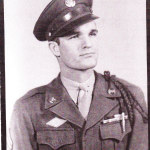 From a hand-me-down 1927 Falcon roadster to an unique Army M-15 Half-Track, Robert D. Fischle’s journey from an Anaheim High graduate to World War II hero involved an amazing collection of unique cars, trucks and other vehicles that not only took him along the roads of life, but defined the path his life would take. Still living in Anaheim near his alma mater, Robert “Fish” Fischle shared his story of serving in WWII in his autobiography, “Small Town Kid to Big Time War.”
From a hand-me-down 1927 Falcon roadster to an unique Army M-15 Half-Track, Robert D. Fischle’s journey from an Anaheim High graduate to World War II hero involved an amazing collection of unique cars, trucks and other vehicles that not only took him along the roads of life, but defined the path his life would take. Still living in Anaheim near his alma mater, Robert “Fish” Fischle shared his story of serving in WWII in his autobiography, “Small Town Kid to Big Time War.”
Before “Fish” writes about his experience as a soldier in WWII, including being a part of the Battle of the Bulge, one of the war’s most famous battles, he fondly recalls his years at Anaheim High. He entered Anaheim High after it was rebuilt due to damage from the 1933 Long Beach earthquake. “I was entering a new school that was almost complete except for the swimming pool and gym,” he writes.
These were innocent times when Bob enjoyed playing football, basketball and running track throughout his four years at AUHS. Like most boys, he was fascinated with cars. His first car during his years at Anaheim Union High School was a Willy’s roadster. When Bob “Fish” Fischle and his best buddy Bob Spielman came up with a quarter, they headed for to the nearest station to fill up on 10.9-cents- a-gallon-gas then headed the roadster to Huntington Beach. He traded in the hand-me-down in his senior year for a 1934 Ford V-8 convertible with roll-up windows and a rumble seat, purchased for $175 from the older brother of his best friend Bob Spielman.
Little did Fischle know during this time of as an Anaheim teenager that life would change dramatically when the Japanese army attacked the Hawaiian Islands on Dec. 7, 1941. He would soon be serving as a gunner of one of the U.S. Army’s most unique vehicles – a M-15 armored anti-aircraft half-track unit with two 50-caliber machine guns that fired 500 rounds per minute and a 37-millimeter canon that fired 120 rounds per minute. The large truck-type vehicle was equipped with front wheels and rear tracks; thus the name half-track.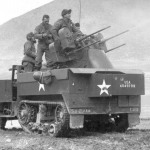
Robert received his draft notice Jan. 23, 1943, on his 19th birthday, as a student at Fullerton Junior College. Robert reported to Fort MacArthur in San Pedro. His training started at Camp Haan near March Air Force Base, then on to the Mohave Desert to Camp Irwin. He was assigned to the Elite 390th Special Battalion Unit of 675 soldiers. This special battalion was called the “AAA-AW-BN,” which stood for Anti-Aircraft Artillery-Automatic Weapons Battalion.
After a little more than one year of training, Robert’s battalion was shipping out on April 6, 1944 from Camp Shanks, New York, to Glasgow Harbor, Gureck, Scotland, assigned to fight in the Third Army commanded by General George Patton. From June 29, 1944, to his date of discharge four years later, Robert traveled with his Battalion from Scotland, through England, France, Luxembourg, Germany, Czechoslovakia and Austria.
On July 7, 1944, the 390th Battalion landed on Utah Beach with the mission to protect the Third Army’s supply dumps. As they began their advance across Europe, the main objective was to shut down enemy aircraft to prevent destruction of bridges. Keeping these structures intact was of vital importance to the success of U.S. Army operations. “We advanced day and night, over mountains, through dense forests, across broad rivers, pressing ever onward in pursuit of victory,” Robert recalls in his memoirs.
Their 281-day campaign culminated with an important appearance in the Battle of the Bulge, the last major engagement of the United States in the European theater. This 40-day battle, fought in Belgium from Dec. 16, 1944 through Jan. 25, 1945 in the freezing cold, was the largest and bloodiest battle Americans fought in World War II, extending across 90 miles of front, leaving 90,000 Americans wounded and 19,000 dead.
The 390th made history during the Battle of the Bulge, shooting down 13 German planes in 17 minutes. The Germans were in retreat and it was over for the Nazi party and Hitler’s black-coated “SS” troops, also known as the Nazi elite. The 390th Battalion received commendations from U.S. Army General George Patton, General Dwight D. Eisenhower, General Marshall, General Bradley and many more.
The end of March 1945 was the beginning of what has been called the “Rat Race” to Germany. On April 30, 1945, Hitler committed suicide along with his wife of one day, Eva Braun, his mistress of many years; thus, ending the Third Reich and which surrender unconditionally on May 8, 1945.
 After the war ended, Robert returned to Anaheim and married Barbara Cordill, Class of 1944. Barbara passed away Nov. 4, 2014, at age 87.
After the war ended, Robert returned to Anaheim and married Barbara Cordill, Class of 1944. Barbara passed away Nov. 4, 2014, at age 87.
We of the Anaheim High School Alumni Association salute the Anaheim-born Colonist hero.
Anaheim High Fallen Heroes & Colonist Veterans
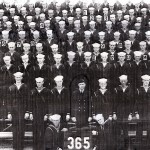
Class of 1944 Colonists graduated on D Day, June 7, and left directly for boot camp in San Diego before heading to the Pacific Theater.
The AHS Alumni Association is working diligently to honor the valiant men and women from Anaheim High School who perished while serving their country from WWI to the War on Terror. Thus far, the Anaheim High Fallen Heroes and Colonists Veterans Project has resulted in the identification of 59 Anaheim High Fallen Heroes who are listed here: Fallen Heros-2013 – NOV 11
Started in 2009, the Project is still undergoing and will ultimately produce a list on more than 1,000 Anaheim High veterans. Biographies and photos of several Anaheim High’s Fallen Heroes and Colonist Veterans are available by visiting the “Wall of Valor” on this website.
To submit a name, please fill out the AHSAA Military Form and email back to anaheimalumni@yahoo.com or mail to AHSAA, P.O. Box 389, Anaheim, 92815.
As time permits, each Fallen Colonist will have his or her story published on the AHSAA website to ensure that our Anaheim High veterans, who served in the Pacific, Atlantic and all parts of the world in all branches of the military, will never be forgotten.
For additional information, e-mail anaheimalumni@yahoo.com.
Brigadier General Nolan J. Beat, USMC – AUHS Class of 1936
 Former Colonist and Marine Corps Brigadier General Nolan J. Beat passed away at age 95. He served his country from October 1942 through April 1976. Brigadier General Beat had the distinction of achieving the highest rank of any Colonist to serve in the United States armed forces. He was buried with full military honors at Riverside National Cemetery on Dec. 20, 2014.
Former Colonist and Marine Corps Brigadier General Nolan J. Beat passed away at age 95. He served his country from October 1942 through April 1976. Brigadier General Beat had the distinction of achieving the highest rank of any Colonist to serve in the United States armed forces. He was buried with full military honors at Riverside National Cemetery on Dec. 20, 2014.
During his nearly 34 years of service with the U.S. Marine Corps, Nolan Beat saw tours of duty in WWII, Korea and Vietnam, earning the Legion of Merit with Combat “V” with two Gold Stars, Joint Service Commendation Medal, Navy Commendation Medal with Combat “V” and the Vietnam Cross of Gallantry with a Silver Star. [Read more…]
Jerry Shipkey – Class of 1943
Legendary Hall of Fame athlete Jerry Shipkey has the distinction of being the only person to play in the Rose Bowl for both USC and UCLA. But his accomplishments as an athlete include much more. Shipkey went on to a standout career in professional ball with the Pittsburgh Steelers and was also a record-setting track and field star in high school and college. [Read more…]
Ulysses Edward “Ude” Bauer – 1926-2013
Ul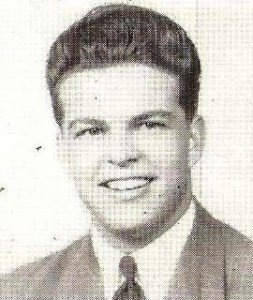 ysses Bauer, a beloved husband, father, grandfather, great-grandfather and friend, passed away peacefully on Nov. 1, 2013, at his home in Forest Falls, CA. Services will be held Tuesday, Nov. 19, 10 a.m., at St. Boniface Catholic Church, followed by internment at Riverside National Cemetery at 2:15 p.m.
ysses Bauer, a beloved husband, father, grandfather, great-grandfather and friend, passed away peacefully on Nov. 1, 2013, at his home in Forest Falls, CA. Services will be held Tuesday, Nov. 19, 10 a.m., at St. Boniface Catholic Church, followed by internment at Riverside National Cemetery at 2:15 p.m.
Known to family and friends as “Ude,” he was born in Anaheim on March 14, 1926, the eldest of four children of Ulysses F. and Cora (Stoffel) Bauer. While at Anaheim High, Ude was a star athlete and played on the 1943-44 Varsity Football Team that won a co-Sunset League championship. He was also a member of the Colonist Knights. 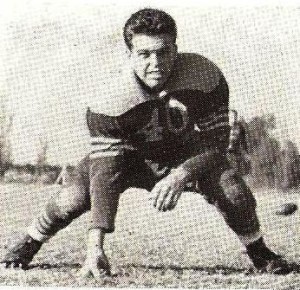
When he graduated from Anaheim Union High School in June 1944, the United States was fighting in both the European and Pacific Theaters. He and 13 of his classmates left after graduation ceremonies for the U.S. Navy boot camp in San Diego. [Read more…]
